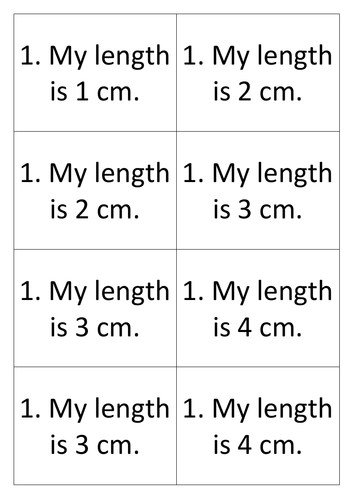












Young people love trading games…Share out to everyone the cards…they then roam the room trading one for one until they make up matching sets. Once they get a matching set they check with the adult who gives them a token if right.
This set has 72 matching sets of 9 cards - a massive piece of work!
First a picture (not to scale) of a rectangle with it’s length and width labeled.
Card 1 - A length
Card 2 - A width
Card 3 - The area
Card 4 - the length plus the width (i.e. 1/2 the perimeter
Card 5 - The perimeter
Card 6 - A comparison of the length and the width
Card 7 - Whether the shape is a rectangle or a square
Card 8 - A comparison of the values of the perimeter and area.
It was originally designed to have lots of similar areas and perimeters so that there are many matching sets of cards without learners having to find a unique matching set.
You need to plan carefully how you are going to use it, what the ability is of your users and how collaborative they can be. Then print out accordingly. Below are a few suggestions.
Print out the nine separate cards on different colour cards. Cut them out. Then spend 15 minutes making stacks of the nine cards (obviously not matches). You then distribute a stack to each learner. Learners then need to collect matching sets which have one of each colour. Once they have a matching stack you issue a token and given them another stack so that they can continue playing until you call time.
You can give some element of control to this by first insisting that they first only trade with their table partner, then only on their tables. This helps to identify who is going to struggle (and/or go off task). You can then manage them trading with another particular table and eventually it becomes a free for all and they all get up.
You can make the task easier by printing out on different colour cards so that the every eight cards (one page) of each card set is printed out on a different colour card. This means that learners can look for cards which are the same colour as theirs.
You can reduce the number of cards - either by only printing out a limited number so that learners have to pair up to make a complete set.
You can make the game significantly harder by removing the picture cards and slightly harder by removing the 1/2 perimeter cards
You can make the game easier by removing all but the picture, area and perimeter cards.
When I say easier, this can mean take less time to play. It’s worth trying with a few different classes to see how they respond (and behave).
Watch out for students who give all their cards away and then opt out. Or small groups of students who go to one corner and share with each other and then don’t move around the room (although the tokens usually motivate most).
I’ve included a matching worksheet but there are plenty of these allready on the TES which others have made.
Something went wrong, please try again later.
This resource hasn't been reviewed yet
To ensure quality for our reviews, only customers who have purchased this resource can review it
Report this resourceto let us know if it violates our terms and conditions.
Our customer service team will review your report and will be in touch.